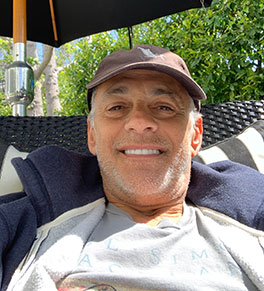Help for a painful kidney stone

UCI Health kidney specialist Dr. Roshan Patel made quick work of Stephen Klarich's kidney stone.
Just after midnight last Dec. 1, Stephen Klarich found himself in the emergency room in excruciating pain with unrelenting vomiting.
Doctors at the community emergency department ordered scan that showed a pea-sized kidney stone. They sent the 63-year-old Irvine resident home with a cup and a strainer to catch any pieces of the 9-millimeter stone that might pass through his urine, and instructed him to contact his urologist.
“I’ve never had a kidney stone,” says Klarich, a criminal defense attorney with a practice in Tustin. “I thought it was some kind of food poisoning. But it was weird that I didn’t feel better after I threw up.”
Klarich waited it out for several days. “I’m not big on going to doctors. After four days, five days, six days, I was feeling fine. I thought [the stone] had passed. So, I let it go.”
Time to see a specialist
After a second trip to the local ED on Jan. 4 with identical symptoms, and an ultrasound confirming the stone was still in place, Klarich went looking in earnest for a urologist.
A few weeks later, he settled on Roshan M. Patel, MD, a kidney disease specialist with the UCI Health Kidney Stone Center.
“I liked what he had to say, and I liked him,” Klarich says. “He held my hand, looked me in the eye, which was nice, and said: ‘You’re going to be OK.’ And he meant it.”
Kidney stones are hardened deposits of minerals and acid salts that stick together in concentrated urine, forming over months or even years. About 10% of men and 8% of women in the United States are likely to develop one in their lifetime.
But the condition, which can be extremely painful, is highly treatable with an array of noninvasive and minimally invasive methods.
Too big to pass
Small stones under 5 millimeters — smaller than a pencil eraser — may pass naturally through the urinary tract, but surgical or non-surgical procedures are often needed to break up larger stones that are causing pain.
“By the time Stephen came to the kidney stone center, the likelihood that his stone would pass on its own was near zero,” Patel says.
Patel scheduled Klarich for an outpatient endoscopic procedure in a surgical suite specifically designed to treat kidney stone patients using the most advanced equipment available. He would use laser lithotripsy to blast the stone apart.
“I was hoping the surgery happened before it moved again, and it did,” Klarich says.
Outpatient laser surgery
The 45-minute outpatient procedure is called a ureteroscopy. While Klarich was anesthetized, Patel inserted a thin, flexible scope through the urethra and bladder then up into the ureter to locate the stone.
He passed the laser through the scope to break up the stone into small fragments, then used a tiny basket to remove all of the pieces.
“I blink my eyes and the next thing I know I’m in recovery,” says Klarich, who returned a week later to have a stent removed.
“The surgery was completely successful, and I was so happy.”
Preventing future stones
The next step was to work with Klarich on prevention, given that people who have had one kidney stone often experience another.
“The stone particles that were captured during surgery were analyzed to understand their chemical composition,” Patel says. Combining that information with results of blood analysis and urine collection studies — called a metabolic workup — Klarich was coached on changing his fluid intake patterns and adjusting what he eats.
While no one really knows why one in 10 people will develop a kidney stone, lifestyle factors such as diet, exercise and especially low fluid intake play a role. “Usually the best medicine is prescribing no medicine at all but encouraging hydration,” Patel says.
But for those who are suffering from a kidney stone, the UCI Health Kidney Stone Center offers same-day office visits and expedited procedures by fellowship-trained kidney specialists who can remove any blockage and quickly get patients back to their regular life.
Klarich can attest to that.
“I tell you, these doctors and nurses, they’ve done this before. And forget medicine and technology, they’re trained in humanity,” he says. “I think that’s great — it mattered to me.”




